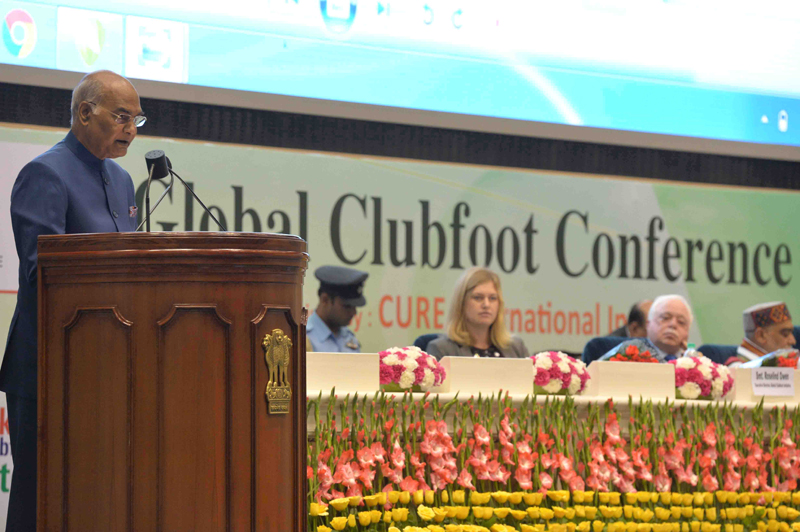ADDRESS BY THE PRESIDENT OF INDIA, SHRI RAM NATH KOVIND ON THE OCCASION OF INAUGURATION OF THE GLOBAL CLUBFOOT CONFERENCE
Bengaluru : 01.11.2017

1. I am happy to be here to inaugurate the first Global Clubfoot Conference to be held in India, and being organised by CURE International India Trust in collaboration with the Ministry of Health and Family Welfare, Government of India, and other partner institutions. I welcome the 500 doctors from 29 Indian states who are attending this conference – and in particular the health specialists from approximately 20 countries who have made it here.
2. Clubfoot is one of the most common orthopaedic birth defects. It can cause permanent disability if not treated early. This affects the child’s mobility and confidence. Inevitably, education and schooling suffer – and the child cannot fulfil his or her potential.
3. The irony is clubfoot is curable. It is estimated that over 50,000 children are born annually in India with clubfoot. The exact reasons for this congenital disability are not fully known. Till recently most children who suffered from clubfoot needed to be treated surgically. This was expensive for parents and traumatic for both the children and their families. Access to surgery was also difficult in rural areas. As such, many received no treatment. They were left to a lifetime of disability and stigma.
4. In India the burden of disability affects more than 10 million people. The differently-abled or Divyang as we call them deserve equal opportunities in all avenues of life. Mainstreaming their social and professional experience is a commitment for all of us. Having said that, many of these disabilities are preventable or curable – which is often forgotten. Prevention, treatment and mainstreaming have to go in parallel.
5. Let us take the example of polio, a disease that is sometimes confused with clubfoot. India is proud that we have eradicated new cases of poliomyelitis. Polio was once a serious cause of loco-motor disability, but over the past six years we have not had a single case of paralytic poliomyelitis. This has been a major milestone in the history of public health not only in India but globally. It must motivate us to work towards eliminating other disabilities and other diseases. Certainly, it must motivate us to take on and defeat the challenge of clubfoot.
Friends
6. We are indeed fortunate that a relatively recent method – the Ponseti method – has been developed to treat and correct clubfoot without surgery. This is now considered the gold standard in treating clubfoot. And it takes away the need for surgery. The question is of access. The Ponseti method and the treatment of clubfoot require that all children who suffer from it are able to get a full course of treatment. This also requires several years of follow-up. If we want to succeed, we have to treat this like a mission – as was the case with polio or earlier smallpox.
7. That is why I am happy to learn that public hospitals are partnering with CURE International India to reach out to as many children as possible. Such collaborative efforts between the government and civil society organisations are heartening. The programme is now active in 29 states of India, with teachers in government medical colleges and doctors in the public health system participating.
8. The programme began in 2009. In the eight years that it has been run, it has enrolled 40,000 children for treatment. Already, it is the largest such programme in the world. I congratulate all stakeholders in this programme – especially the National Health Mission, which has helped identify a large number of children with clubfoot. State governments too are to be commended for taking up the challenge of treatment in partnership with CURE International India.
9. And finally, we need to appreciate the professors, doctors and health workers in medical colleges and district hospitals across the country. They are our front line soldiers against clubfoot.
10. Despite these successes, we cannot ignore that at the current rate only 8,000 fresh cases are brought into the ambit of treatment every year. This is a small number if one considers the 50,000 children who are born annually in India with clubfoot. In 2022, India completes 75 years of its Independence. It should be a national resolve that by then every child born with clubfoot gets access to treatment services as soon as the condition is diagnosed.
11. We owe it to the next generation to defeat and remove clubfoot from our list of public health challenges. We owe it to every child who suffers, and every mother and every father who winces in agony for his or her child. Like in the case of polio, this will need a multi-pronged, multi-stakeholder approach involving public and private agencies and health-care providers, government and civil society organisations – and frankly the efforts of our entire society.
12. I am confident this can be done. We all know the history of clubfoot. By 2022, we simply have to make clubfoot history.
I wish all of you and this conference the very best